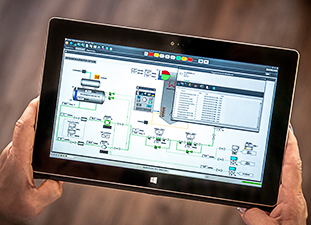Siemens continues setting new standards with the SPPA-T3000 I&C system

Siemens pushed development of its SPPA-T3000 I&C system forward. The newly designed user interface offers enhanced, optimized operating efficiency.
The key consideration for the layout and design of the new SPPA-T3000 user interface was to ensure that the operator can intuitively react reliably and correctly in any situation. Vital criteria for this included prioritization, individualization and ergonomics. Priority functions for daily use have now been placed prominently in clear view in the control bar and can be quickly activated with one click of the mouse.
All other functions are arranged lower in the hierarchy in the function library and can be reached with one to two clicks. The operator can decide individually which functions are to be displayed in the control bar. Besides the new user interface, the “traditional” user interface is also available for further use. Ergonomic guidelines apply to the visualization of all functions, for each of which a self-explanatory icon has been developed.
With these easily recognizable icons, the new user interface is not only suitable for use on conventional computers, but on touch-screen devices as well. This new user interface will be available in all new SPPA-T3000 installations and can also be integrated into existing systems.
Two “trip stop” buttons were also developed as a new alarm class for SPPA-T3000. These buttons are integrated in the control bar of the new user interface and enable the operator to react quickly, appropriately and reliably in critical situations. The “trip warning” button is used to evaluate trip-relevant scenarios and generate warning messages to which the operator must give special attention to avoid unwanted shutdowns.
The “trip stop” button can be used in situations in which a sudden fault requires an immediate reaction. This button provides brief, pre-defined instructions on actions to take to avoid unwanted shutdowns, along with an associated user window that the operator can use to help bring the critical situation quickly under control.
The need for central control rooms has arisen as a result of demographic and economic developments. Central control rooms must be capable of operating an entire fleet comprising various power plant installations with dissimilar instrumentation and control systems as if the control room were on hand at each power plant site.
For this purpose the SPPA-T3000 control system is deployed in a multiple-unit configuration, thereby providing the basis for implementing a homogenization concept that enables operators in the control room to safely and reliably control each individual remote installation, even – and in particular – under critical conditions. A transformation server is provided at each installation to act as a “translator” in this process.
This transformation server compiles all the necessary data from the original systems in the SPPA-T3000 data topology without having to convert or replace the original systems. Operators in the central control room have a secure handle on the entire fleet at all times, thanks to the system's uniform operating and signaling philosophy.
“In the further developed SPPA-T3000 we realized our innovations, which integrate operational experience and practical needs of our customers”, stresses Dieter Fluck, Vice President Product Management in the Siemens Energy Instrumentation, Controls & Electrical business unit.
“The new user interface and optimized alarm handling now provide our customers with an even faster and more reliable operation of their power plant. Our central control room concept contributes to a substantial reduction in operating costs and, thus, to more competitiveness of our customers.”
SPPA-T3000 is Siemens' world-leading I&C system for use in all types of power plants, regardless of the type of power generation or size of the plant. The system spans all functions from boiler and turbine controls up to open and closed-loop control of all power plant processes. It is also well-suited for enterprise fleet management.
Contact
Media Contact
All latest news from the category: Power and Electrical Engineering
This topic covers issues related to energy generation, conversion, transportation and consumption and how the industry is addressing the challenge of energy efficiency in general.
innovations-report provides in-depth and informative reports and articles on subjects ranging from wind energy, fuel cell technology, solar energy, geothermal energy, petroleum, gas, nuclear engineering, alternative energy and energy efficiency to fusion, hydrogen and superconductor technologies.
Newest articles

New anti-cancer agent works without oxygen
Why tumors shrink but don’t disappear. “As tumors grow very quickly, consume a lot of oxygen and their vascular growth can’t necessarily keep pace, they often contain areas that are…

First blueprint of the human spliceosome revealed
Researchers detail the inner workings of the most complex and intricate molecular machine in human biology. Researchers at the Centre for Genomic Regulation (CRG) in Barcelona have created the first…

A paper-aluminum combo for strong, sustainable packaging
Takeout containers get your favorite noodles from the restaurant to your dining table (or couch) without incident, but they are nearly impossible to recycle if they are made from foil-lined…



